-
Product Name
Cytokeratin 14 antibody
- Documents
-
Description
Cytokeratin 14 Rabbit Polyclonal antibody. Positive IF detected in HepG2 cells, MCF-7 cells, mouse olfactory epithelium tissue. Positive IHC detected in human lung cancer tissue, human cervical cancer tissue, human kidney tissue, human liver tissue, human oesophagus cancer tissue, human placenta tissue, human prostate hyperplasia tissue, human skin cancer tissue, human skin tissue, mouse skin tissue. Positive WB detected in A431 cells, rat skin tissue. Positive IP detected in A431 cells. Observed molecular weight by Western-blot: 47-50 kDa
-
Tested applications
ELISA, WB, IF, IP, IHC
-
Species reactivity
Human,Mouse,Rat; other species not tested.
-
Alternative names
CK 14 antibody; CK14 antibody; Cytokeratin 14 antibody; EBS3 antibody; EBS4 antibody; K14 antibody; keratin 14 antibody; KRT14 antibody; NFJ antibody
- Immunogen
-
Isotype
Rabbit IgG
-
Preparation
This antibody was obtained by immunization of Cytokeratin 14 recombinant protein (Accession Number: NM_000526). Purification method: Antigen affinity purified.
-
Clonality
Polyclonal
-
Formulation
PBS with 0.02% sodium azide and 50% glycerol pH 7.3.
-
Storage instructions
Store at -20℃. DO NOT ALIQUOT
-
Applications
Recommended Dilution:
WB: 1:500-1:5000
IP: 1:500-1:5000
IHC: 1:20-1:200
IF: 1:20-1:200
-
Validations
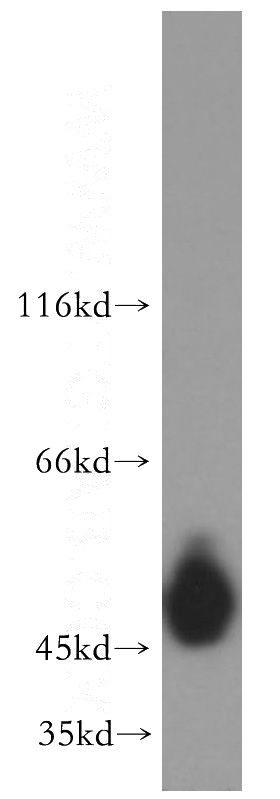
A431 cells were subjected to SDS PAGE followed by western blot with Catalog No:109792(KRT14 antibody) at dilution of 1:1000
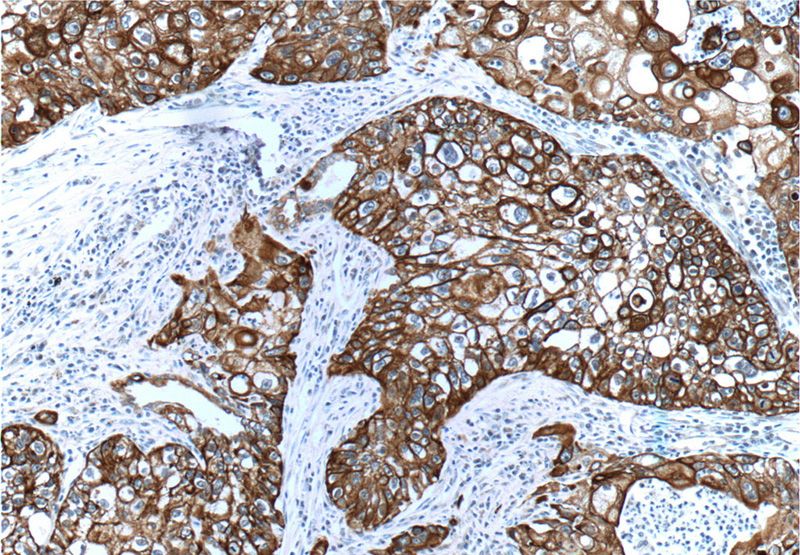
Immunohistochemistry of paraffin-embedded human lung cancer tissue slide using Catalog No:109792(KRT14 Antibody) at dilution of 1:200 (under 10x lens)
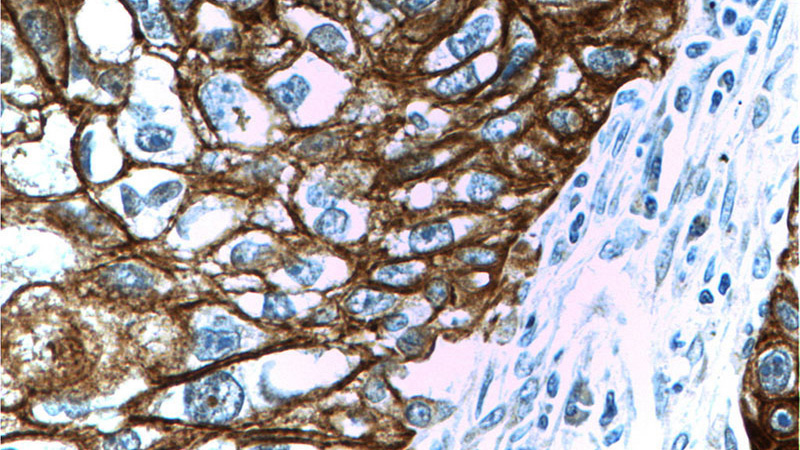
Immunohistochemistry of paraffin-embedded human lung cancer tissue slide using Catalog No:109792(KRT14 Antibody) at dilution of 1:200 (under 40x lens)
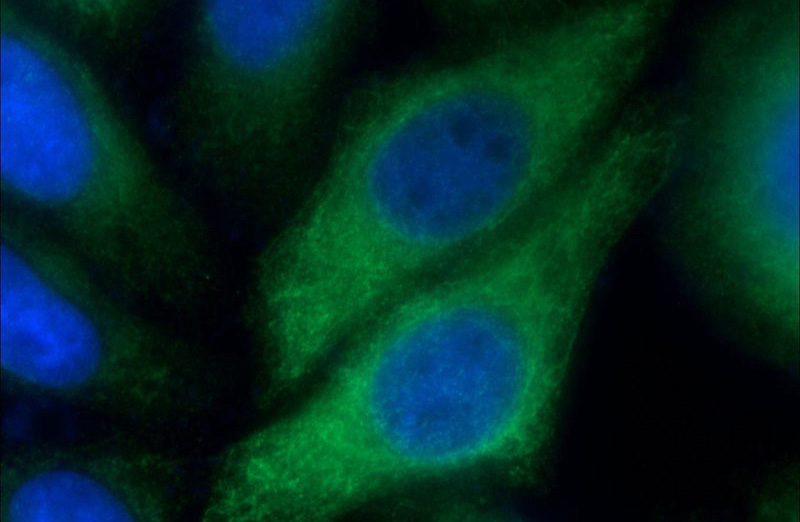
Immunofluorescent analysis of HepG2 cells using Catalog No:109792(KRT14 Antibody) at dilution of 1:50 and Alexa Fluor 488-congugated AffiniPure Goat Anti-Rabbit IgG(H+L)
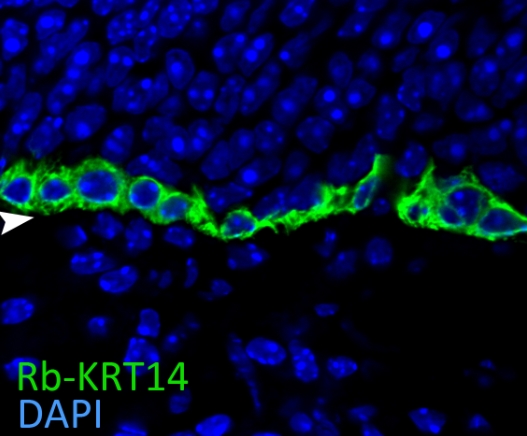
IF result of CK14 (Catalog No:109792, 1:400) with 1% PLP fixed basal quiescent stem cells of the adult mouse olfactory epithelium. (Green: CK14; Blue: DAPI). Basal lamina is marked by an arrow head. By Brian Lin, Tufts University.
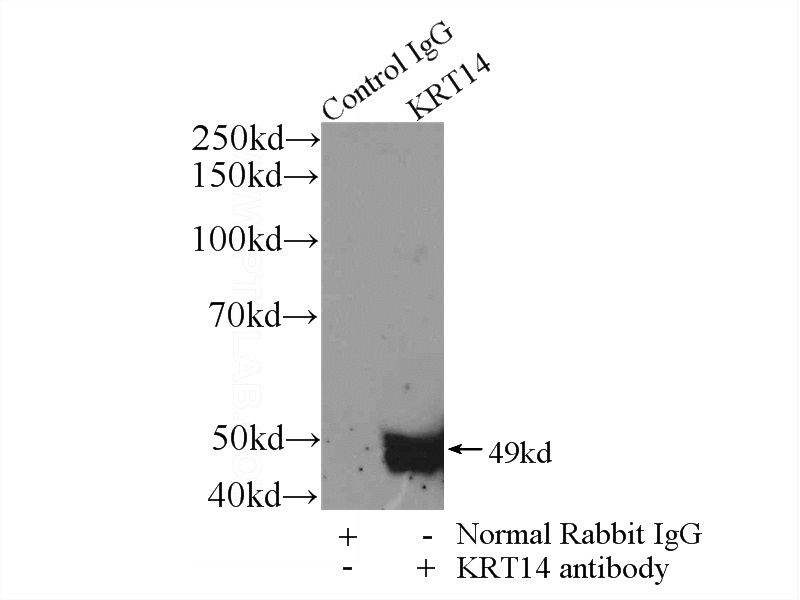
IP Result of anti-KRT14 (IP:Catalog No:109792, 3ug; Detection:Catalog No:109792 1:1000) with A431 cells lysate 1200ug.
-
Background
Keratins are a large family of proteins that form the intermediate filament cytoskeleton of epithelial cells, which are classified into two major sequence types. Type I keratins are a group of acidic intermediate filament proteins, including K9–K23, and the hair keratins Ha1–Ha8. Type II keratins are the basic or neutral courterparts to the acidic type I keratins, including K1–K8, and the hair keratins, Hb1–Hb6. Keratin 14 is a type I cytokeratin. It is usually found as a heterotetramer with keratin 5. Keratins K14 and K5 have long been considered to be biochemical markers of the stratified squamous epithelia, including epidermis.
-
References
- Strand DW, Jiang M, Murphy TA. PPARγ isoforms differentially regulate metabolic networks to mediate mouse prostatic epithelial differentiation. Cell death & disease. 3:e361. 2012.
- Zhe N, Wang J, Chen S. Heme oxygenase-1 plays a crucial role in chemoresistance in acute myeloid leukemia. Hematology (Amsterdam, Netherlands). 20(7):384-91. 2015.
- Yang CF, Yang GD, Huang TJ. EB-virus latent membrane protein 1 potentiates the stemness of nasopharyngeal carcinoma via preferential activation of PI3K/AKT pathway by a positive feedback loop. Oncogene. 2015.
Related Products / Services
Please note: All products are "FOR RESEARCH USE ONLY AND ARE NOT INTENDED FOR DIAGNOSTIC OR THERAPEUTIC USE"
